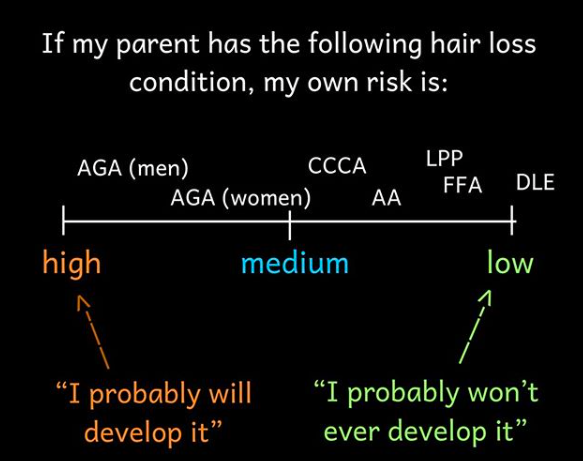What is my own risk of developing hair loss?
A closer look at risk when family parents are affected?
When one hears that a particular condition has a “genetic” basis, a common reaction that follows is “will the children in the family be affected?” The answer comes down to the type of inheritance and the nature of the actual genes. Some conditions carry a high risk and others a low risk.
In the world of hair loss, we are increasingly learning of a genetic contribution for many of the conditions. This means that an individual in the family could be at higher risk for developing that type of hair loss compared to an individual in the general population. However, the risk can range from very high to very low.
Two polar examples on both extremes are male pattern hair loss (high risk) and frontal fibrosing alopecia (low risk). Male balding is complex and over 256 genetic regions contribute to this polygenic condition. Most males who have a dad with balding will develop some amount of balding themselves. For example, in a study of 572 men ages 16-91, young men with a balding father had a 5.5 times increased risk of balding compared ti young men who did not have a balding father. In another study, only 1 of the sons of 50 non balding men had Hamilton Norwood type III balding or worse. In contrast, 32 of 54 (60 %) of sons whose fathers were bald had Hamilton Norwood scale type III baldness or greater.
On the other extreme, frontal fibrosing alopecia is less common. Although the cause is not clear, 4 genes may have a role. Despite now known to have a genetic contribution, the risk for a family member to also develop FFA is still low. In fact, I would estimate that out of every 200 women with FFA I see - maybe 1 or 2 have a mother who also has FFA. The risk is clearly much different than for male balding.
The diagram shows my estimates for risk. Abbreviations include androgenetic alopecia (AGA), central centrifugal cicatricial alopecia (CCCA), alopecia areata (AA), frontal fibrosing alopecia (FFA), lichen planopilaris (LPP), discoid lupus (DLE).
This article was written by Dr. Jeff Donovan, a Canadian and US board certified dermatologist specializing exclusively in hair loss.

